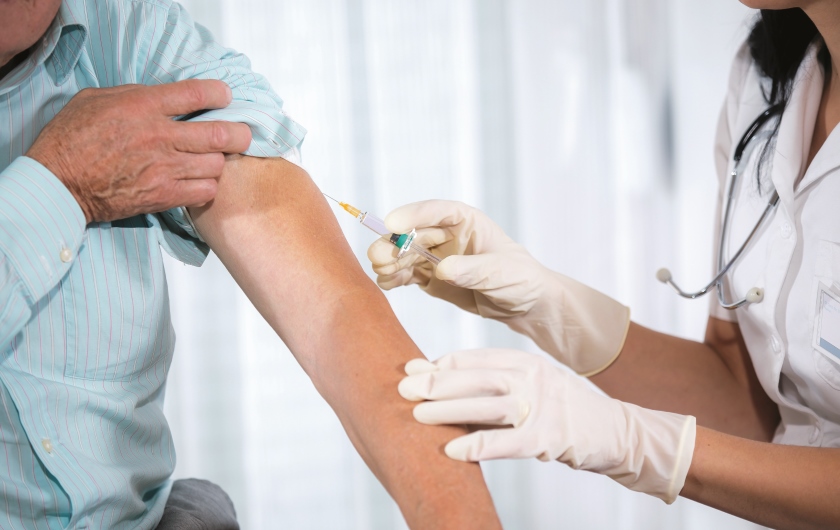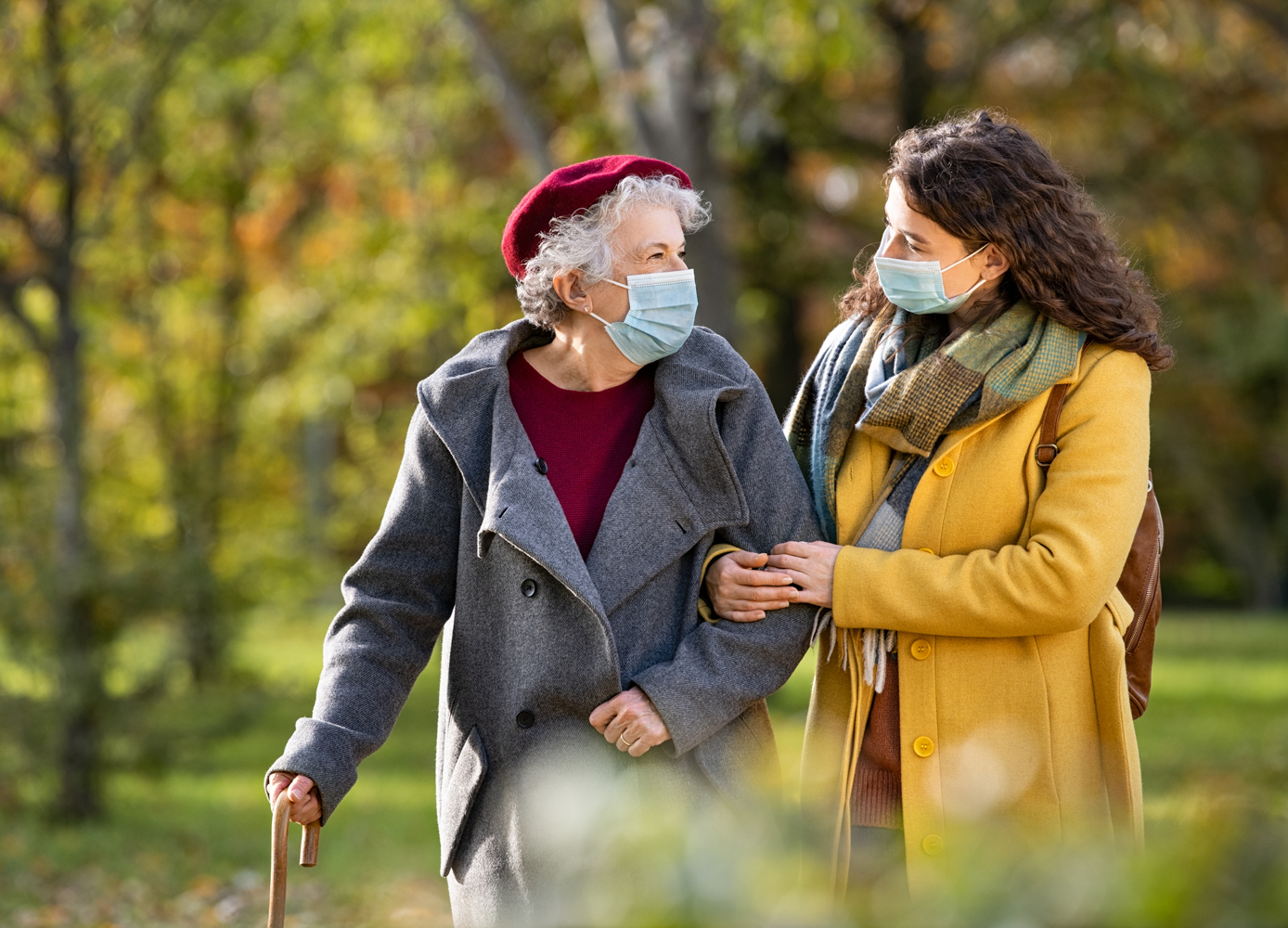The protection afforded by many of your previous vaccinations most likely wore off long ago—you’re probably not just due for a shot, but long overdue
By Wendy Haaf
Photo: iStock/Jovanmandic.
You eat well, exercise regularly, get enough sleep, abstain from tobacco, and drink only in moderation; surely you’re doing everything you can to stay healthy, right? As it turns out, you’re probably overlooking something equally important and much simpler to do. According to a 2018 report from the CD Howe Institute, more than 90 per cent of older Canadians have missed at least one of the recommended routine immunizations that stave off serious illness and related complications.
“Immunization isn’t just for children,” says Dr. Shainoor Ismail, a senior medical specialist with the Public Health Agency of Canada’s Centre for Immunization and Respiratory Infectious Diseases. Not only is it a safe and effective way to protect against vaccine-preventable diseases throughout adulthood, but it becomes even more important with the passing years. “As you get older, your immune system weakens,” Ismail explains; this then increases your chances of getting infections if you’re exposed and ups the odds of developing complications that can lead to long-term illness. Similarly, chronic conditions such as diabetes, heart disease, and lung disease increase these risks—and roughly half of Canadians 50 or older are living with at least one such condition.
With that in mind, here’s a rundown of the routine immunizations that are recommended for those of us who’ve passed the half-century mark.
Influenza
Frequency: Every fall
The aches, fever, and flat-on-your-back exhaustion that can accompany influenza are no fun at any age, but “the flu takes quite a toll on older people,” says Dr. Stephen J. Wetmore, the chair/chief of the Department of Family Medicine at Western University’s Schulich School of Medicine & Dentistry in London, ON. In 2014–15, adults 65 or older accounted for 71 per cent of influenza-related hospitalizations in Canada and 91 per cent of influenza-related deaths. (A hospital stay itself, regardless of the reason, can lead to other problems, such as rapid muscle loss due to inactivity; in fact, studies suggest that, following hospital discharge, up to a third of older adults have a reduced ability to carry out the activities of daily living.) There’s even evidence that infection with influenza boosts the risk for serious cardiovascular events such as heart attack as much as sixfold, says Dr. Mark Loeb, the director of the Division of Infectious Diseases at McMaster University in Hamilton, ON, where he is also a professor.
While the exact amount of protection conferred by influenza vaccine varies from year to year depending on how well it matches the viruses that are circulating, a recent meta-analysis found that overall, immunization cuts the odds of developing laboratory-confirmed flu infection in half for older adults. (That means you’re also less likely to pass the illness on to vulnerable people such as those undergoing cancer treatment and babies too young to be immunized.) In addition, according to the US Centers for Disease Control and Prevention, vaccination sharply decreases the chance of developing symptoms severe enough to warrant hospitalization among adults aged 65 or older (rates are cut by roughly a third for one family of flu viruses and by more than half for another). It’s also linked with lower rates of hospitalization in people with diabetes and chronic lung disease.
Consequently, all provincial health plans cover an annual flu shot (typically a quadrivalent vaccine that protects against four strains: two A type and two B) for those 65 or older (60 or older in Quebec) and those at high risk for complications. In addition, in all but three provinces—British Columbia, New Brunswick, and Quebec—influenza immunization is publicly funded for all adults.
For people 65 or older, the options for influenza vaccinations have expanded beyond the usual shot. The two additional routes are aimed at boosting the body’s response to the vaccine (which is impaired by the same age-related decline in immune function that makes it harder to fight off infections): one is via a higher dose; the other is via the use of a harmless additive. “The high-dose vaccine is certainly something seniors should strongly consider or speak with their physicians about,” Loeb advises. Currently, Ontario is the only province to pick up the tab for the high-dose shot for older people who don’t reside in long-term care; however, some private health plans may cover the cost.
Pertussis
Frequency: Once during adulthood
If it’s been a long time since you had a tetanus and diphtheria booster, you may not be adequately protected against pertussis, more commonly known as whooping cough. As of 2003, Canada’s National Advisory Committee on Immunization (NACI) has recommended that all adults get at least one dose of pertussis vaccine (usually combined with the tetanus and diphtheria vaccine in a single shot) to bolster their immunity to the disease.
While this move was largely intended to prevent periodic outbreaks of the infection (which is potentially life-threatening to infants, particularly those too young to be fully immunized), the protection, albeit limited, that the shot affords adults is worthwhile, too: the disease was dubbed “the 100-day cough” for good reason. Currently, only a small minority of Canadians 65 or older—8.9 per cent—have received the pertussis booster.
The provinces varied in terms of when they added the pertussis booster to their publicly funded immunization schedules after the 2003 NACI recommendation, so depending on where you have lived since then, you may still not have gotten it even if you’ve had a tetanus and diphtheria booster.
Diphtheria and Tetanus
Frequency: Every 10 years
While diphtheria has been rare in Canada since immunization programs were first implemented here, it’s still possible to be exposed to the infection (which is fatal in up to three per cent of cases) via visitors from and visits to countries where outbreaks continue to occur.
And while you can’t catch tetanus from another person, spores of the bacteria that lead to the disease are all around us in soil and dust, and can enter the bloodstream through a break in the skin, such as scrapes and animal bites; the resulting infection can be fatal. Both vaccines (or the combined shot) are extremely effective, protecting nearly every recipient for almost 10 years.
Pneumococcus
Frequency: Once at age 65
NACI recommends that all adults 65 or older (and younger adults with certain medical conditions, such as chronic kidney, heart, and lung disease, as well as diabetes) receive one dose of a vaccine that protects against infections caused by 23 strains of Streptococcus pneumoniae (commonly known as “pneumococcus”) bacteria. “It protects against serious illness from pneumococcal infection, such as pneumonia and meningitis,” Ismail explains. The most common of these, pneumococcal pneumonia, kills one in 20 people aged 65 or older who contract it. Other invasive diseases caused by the bacteria, such as blood infections, while rarer, are much more deadly, killing roughly one in five people 65 or over who contract them. The 23-valent vaccine (that is, protecting against the previously noted 23 strains) is approximately 50 to 80 per cent effective at preventing such infections, and “it’s the only one that’s been proven definitively to reduce the risk for pneumonia due to exposure to pneumococcal strains,” Loeb says.
For those who need additional protection, a second, newer vaccine may be considered. (The two can’t be given together, though: you must wait a year before getting the newer shot.)
“It protects against fewer strains [13], but they’re the most important ones,” Loeb says. “And it protects to a greater degree in terms of antibody production.” Like the high-dose flu shot, however, the 13-valent vaccine isn’t publicly funded for seniors, so you’ll have to pay for it out of pocket or via private health insurance.
Herpes Zoster
Frequency: Once after age 50
Caused by a reawakening of the chicken pox virus that had been lying dormant in the nervous system, herpes zoster—known more commonly as “shingles”—announces itself with a blistering, painful rash and can lead to complications ranging from vision and hearing loss to facial paralysis, with excruciating nerve pain lasting three months or longer as the most common complication. (Called “post-herpetic neuralgia,” this lingering condition affects up to one-third of those who develop shingles.) While shingles and its associated complications can strike at any point in life, the likelihood starts rising sharply after age 50, as do the odds of developing a severe case. In one study, 10 per cent of shingles patients 65 or older needed to be admitted to hospital, compared with just one per cent of those 44 or younger.
NACI now recommends that all adults 50 or older be offered a new vaccine against herpes zoster. Given in two doses two to six months apart, it has two advantages over an older shingles vaccine: it’s more effective at preventing shingles and post-herpetic neuralgia (90 to 95 per cent versus 70 to 75 per cent) and it works nearly as well when given after age 70 as it does at 50. “People can have it even if they have had shingles or the older vaccine,” says Western University’s Dr. Stephen J. Wetmore. The catch is that it’s not covered by any provincial health plan.
Overall, routine immunization is a great way to reduce significantly the chance you’ll get any of a number of illnesses and have to deal with the potentially life-altering health problems they can lead to. And you’re not the only one who benefits: “Immunization protects not only the adult who is immunized, but it also protects young children and others at risk for vaccine-preventable diseases,” Ismail says. This includes people who need powerful immune-modulating medications and those undergoing cancer treatment. “It doesn’t help keep only you healthy; it does the same for your family and your community.”
Next week: Part II. Find out what to do if you’re not sure whether you’ve received all of your routine recommended vaccinations.






